Recipes
Oatcakes
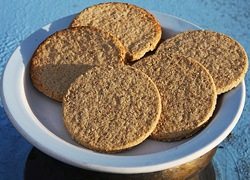 There’s nothing more Scottish than oatcakes.
There’s nothing more Scottish than oatcakes.
They’re easy to make – and they’re very versatile!
Oatcakes go well with cheese, pate, cold meat,
or with sweets.
An ideal snack – good for anytime in the day.
INGREDIENTS – to make about 20 oatcakes
· 140g medium wholemeal flour, plus extra for dusting
· 140g porridge oats
· ½ teaspoon of bicarbonate of soda
· A pinch of salt
· About 2 tablespoons of lard
· About 5 tablespoons of just-boiled water
METHOD
1. Preheat the oven to 180°C/356°F Gas Mark 4.
2. Melt the lard over a medium heat until it has completely melted.
3. Mix all the dry ingredients together in a bowl.
4. Add the lard and enough hot water to mix together until a firm dough. Pat into a flat disc, cover and leave for 10 minutes or so – this makes the dough a little easier to roll.
5. Dust your work surface and the dough with oatmeal and roll out until it is about
half a centimeter thick.
6. Cut as many oatcakes as the shape allows and place them on the baking tray.
7. Place the offcuts aside and repeat steps 5 and 6 with the other half.
8. Mold all the offcuts into a ball and repeat steps 5 and 6 once more.
9. Place the oatcakes into the hot oven for 10 minutes or until the edges are golden brown.
10. Remove the oatcakes from the oven and place them on a cooling rackfor about 5 minutes to firm up, then transfer to a wire rack to cool.
Either eat straight away, with cheese if you like, or keep for up to a few days in an airtight container.
Rumbledethumps
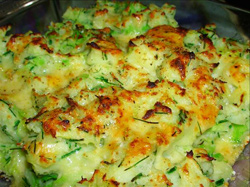 This is the Scottish version of “Bubble and Squeak”. An ideal way to use up left-overs from a previous meal.
This is the Scottish version of “Bubble and Squeak”. An ideal way to use up left-overs from a previous meal.INGREDIENTS – to serve two
· 16 oz potatoes, roughly diced
· 12 oz finely shredded cabbage·
· 1 large onion, finely sliced
· About 2 oz (4 tablespoons) of butter
· About 2 oz (4 tablespoons) of grated white cheddar cheese
METHOD
1. Preheat the oven to 200°C/400°F or Gas Mark 6.
2. Boil the roughly-diced potatoes a medium sized pan.
3. Mash the potatoes evenly.
4. Shred the cabbage and slice the onion (in a food processor or by hand).
5. Place the butter in a frying pan and melt over high heat.
6. Add the cabbage and onion and turn over until coated with butter.
7. Leave for a few minutes, until the cabbage and onion wilt. Do not brown the vegetables.
8. Add half the cheese and all the potatoes, and stir until the cheese has melted over a simmering heat.
9. Season to taste with salt and pepper.
10. Place in a serving dish and sprinkle with the rest of the cheese.
11. Place in a hot oven and bake until the cheese has melted and the top is a golden brown.
Haggis
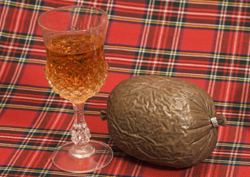 This Scottish recipe comes from the 1700s. It shows the Scots knack of making something out of almost nothing. I believe haggis was perhaps the first processed meat. Scottish winters can be hard (temperatures in Scotland this year have been as low as 20 degrees below zero!). Scotland is about 1000 miles north of Pittsburgh!
This Scottish recipe comes from the 1700s. It shows the Scots knack of making something out of almost nothing. I believe haggis was perhaps the first processed meat. Scottish winters can be hard (temperatures in Scotland this year have been as low as 20 degrees below zero!). Scotland is about 1000 miles north of Pittsburgh!
As autumn drew to a close in Scotland, people looked to the oncoming winter and the inevitable shortage of food. So when they killed the last livestock of the year, everything was used. Some of the internal organs were mixed with grain and suet, and made into a sausage, which when cooked, and preserved by the icy cold, would last through the winter.
This 18th century recipe comes from member Lucy Stewart-Hykes:
“Take the lights, heart and kidneys of a lamb or sheep, but not the liver; boile them, and pick them, and pick out the strings; then shred them small with good store of Beef Suet mingled with Currans, Nutmeg and Salt, grated Bread & Sweet Herbs shred small; the yolks of 3 Eggs and 4 spoonfulls of Cream, stirre them together and put them in the Paunch of a sheep, scowred & cleansed and seasoned for 3 days before; Let it boil 4 houres; serve it in the Paunch; give it a gash carelessly, then it will rune out green.”
NOTE: Our Burns’ Dinner haggis comes from Cameron’s Market of New Jersey. It is prepared using a traditional Scottish recipe – and it doesn’t “rune out green”! Nor, I might add, do the guests!
Fancy a Whisky Mince Pie?
INGREDIENTS
Mincemeat Filling (makes 3llb / 1.35kg) 225g (8oz) apples, peeled, cored and chopped (drier texture apples are best)
-
· 4oz shredded suet
· 14oz dried mixed fruit
· 4oz candied peel, finely chopped
· 6oz dark brown sugar
· Zest and juice of one orange
· Zest and juice of one lemon
· 1oz finely chopped almonds
· 2 teaspoons mixed spice
· ½ teaspoons cinnamon
· ¼ teaspoon nutmeg
· 3 tablespoons Teacher’s Whisky
METHOD
-
1. Combine all the ingredients, with the exception of the Teacher’s in an oven proof bowl.
2. Cover with a muslin cloth and leave to infused for 12 hours, or overnight in a cool place.
3. Pre-heat the oven to 120ºC/248ºF.
4. Remove the muslin cloth and loosely cover the bowl with tin foil and put in the oven.
5. Leave the mixture to heat through for 3 hours to let the flavors develop, then take out of the oven to cool, stirring periodically to help blend the ingredients together.
6. Once cool, add the Teacher’s Whisky and store in an airtight container in a cool dry place.
7. Best eaten within a year of being made.
8. Preheat the oven to 180ºC/356ºF.
9. Flour an even surface and roll out the shortcrust pastry as thinly as possible.
10. Cut the pastry into 8-10 3 inch rounds and the remaining pastry into strips for the lattice topping, ensuring you re-roll the trimmings.
11. Line the cake tins lightly with butter and dust with flour, then gently fit a 3 inch pastry round into each tin.
12. Fill these with the mincemeat mixture until level with the top of the tin.
13. Dampen the edges of the lattice strips with water and press lightly onto each pie to form the top of the pie.
14. Brush the lattice lids with milk.
15. Bake for 25-30 minutes until light golden brown.
16. Cool on a rack and dust the tops with icing sugar. Store in an airtight container.
17. For more information, go to: www.Scotsman.com Whisky.
Hot Toddy
Did you know where the term “Hot Toddy” comes from? Edinburgh once got its fresh water from two wells – and one of these wells was named Tod’s Well. People getting their water often referred to it as a “Tod” or “a Toddy”. Add some whisky and a few other ingredients, and you have a “Hot Toddy”.
INGREDIENTS
-
· 50ml Teacher’s Whisky
· 2 teaspoons vanilla sugar
· Cardamom
· Cinnamon
· The juice of 2 wedges of lemon
· The juice of 1 wedge of orange
· 37.5ml pressed apple juice
· Boiling water
METHOD
- Add 1 pod of green cardamom, a pinch of cinnamon and 2 teaspoons of vanilla sugar to a heat proof glass and gently press the cardamom.
- Half fill the glass with boiling water then pour in the apple juice and Teacher’s whisky.
- Squeeze in 2 wedges of lemon and a wedge of orange, gently stir until the sugar has dissolved and then top up with boiling water.
- If preferred, strain off into a fresh glass and garnish with a cinnamon stick.
When winter arrives in Pittsburgh, what better way to warm up than with a refreshing Hot Toddy. This Teacher’s recipe puts a spicy twist on an old favorite. Ingredients: 50ml Teacher’s Whisky 2 teaspoons vanilla sugar Cardamom Cinnamon The juice of 2 wedges of lemon The juice of 1 wedge of orange 37.5ml pressed apple juice Boiling water.
Scottish Tablet
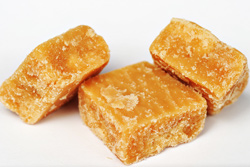 Tablet is an original Scottish confectionary.
Tablet is an original Scottish confectionary.
There are a number of variations, but I prefer the rough, authentic texture shown here.
INGREDIENTS
· 18 oz (2 cups) granulated sugar
· 2 oz (1/4 cup) butter
· 3 ½ tablespoons of condensed milk
· 6 fl oz water (3/4 cup)
METHOD
1. Grease a tin.
2. Place all the ingredients in a saucepan and heat until the butter has melted and the sugar has dissolved.
3. Mix the mixture to the boil. It is important to keep stirring, to make sure the mixture doesn’t stick to the bottom of the pan!
4. Reduce to a simmer, and hold the temperature there for about ten minutes. The mixture should be thick, and the color should change from white to caramel.
5. Take the pan from the stove and place on a heat-resistent surface for about five minutes.
6. Then beat the mixture really hard. At this time it should be beginning to set.
7. Before it sets, use a wooden spoon to transfer it to the prepared tin. It will start to set right away.
8. Before it sets completely, slice it into bite-sized chunks – and leave it to cool and set completely.
9. Take the pieces from the tin and store them in an airtight container – if they make it that far!
Cranachan
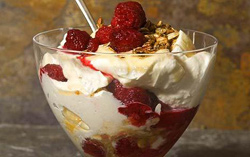 This traditional Scottish dessert is often called “crowdie cream”. In the past, the soft Scottish cheese called “crowdie” was sometimes used instead of cream.
This traditional Scottish dessert is often called “crowdie cream”. In the past, the soft Scottish cheese called “crowdie” was sometimes used instead of cream.
INGREDIENTS – to serve two
· 10 oz fresh raspberries
· 10 fl oz (1 cup) double (heavy) cream
· 2 tablespoons of good quality honey
· 2 tablespoons of single malt whisky
· 2 to 3 tablespoons of oatmeal
METHOD
1. Place the oatmeal in a cool dry pan and simmer, stirring occasionally, toasting the oatmeal until it is a golden brown. This will take between 10 and 20 minutes.
2. Once the oatmeal is golden, turn off the heat and let it cool in the pan.
3. Put the cream in a bowl and whisk until it is soft and thick.
4. Add the honey and the single malt and fold it in until the mixture is soft and creamy.
5. Pick out the best raspberries and add three or four to the bottom of each serving glass, saving a few to decorate the top of each serving glass.
6. Add the raspberries to the cream mixture and fold in carefully – allowing a few to break, to add color to the mixture.
7. Spoon the mixture into the serving glasses, adding some cream to the top, to make an even base for the oatmeal.
8. By now the oatmeal will be cooler, and you can sprinkle some over the top, with a teaspoon.
9. Add a couple of raspberries to the top as the crowning jewels – and chill for three hours, or overnight.
